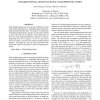Free Online Productivity Tools
i2Speak
i2Symbol
i2OCR
iTex2Img
iWeb2Print
iWeb2Shot
i2Type
iPdf2Split
iPdf2Merge
i2Bopomofo
i2Arabic
i2Style
i2Image
i2PDF
iLatex2Rtf
Sci2ools
ICASSP
2008
IEEE
2008
IEEE
Towards optimal design of signal fingerprinting codes
Digital fingerprinting aims at protecting multimedia contents from illegal redistribution by embedding imperceptible fingerprints identifying the users. We propose two approaches for building fingerprinting codes that accommodate millions of users and resist tens of colluders. These approaches are based on recent information-theoretic analyses of good fingerprinting codes in two regimes: 1) very low rates, and 2) rates near capacity. Good low-rate codes have high minimum distance. Good high-rate codes are short and random-like. Simulation results are presented to assess decoding performance.
Digital fingerprinting Aims | ICASSP 2008 | Illegal Redistribution | Imperceptible fingerprints | Signal Processing |
Related Content
| Added | 30 May 2010 |
| Updated | 30 May 2010 |
| Type | Conference |
| Year | 2008 |
| Where | ICASSP |
| Authors | Jean-Francois Jourdas, Pierre Moulin |
Comments (0)

